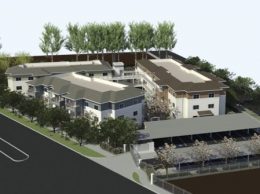Opinion: Oxnard was central to Chicano movement
By Frank P. Barajas
This column is an excerpt from the book “Mexican Americans with Moxie: A Transgenerational History of El Movimiento Chicano in Ventura County, California, 1945-1975,” by Frank P. Barajas.
From the United Farm Workers Boycott Office in Delano, California, Jessica Govea, 24, examined a clipping of a full-page advertisement in the Ventura County Star-Free Press sent to her by Ray Ortiz, the union’s organizer in the city of Oxnard.
Published on Jan. 30, 1971, after the “In Support of Cesar Chavez” title, it declared, “WE ARE MEXICAN-AMERCANS, non-farmworkers who support Cesar Chavez and the work he is doing in [sic] behalf of the farmworkers.” The 240 signatories denounced the attacks of the agricultural industry that branded their champion a deceitful Marxist revolutionary. They also consisted largely, but not exclusively, of Spanish-surnamed residents — many born before World War II, others afterward. The j’accuse intrigued Govea. In her reply letter, she thanked Ortiz and closed with “Looks like you guys are doing some good boycott work. Viva la Causa!”
Three years later, after months of underground organizing on the part of gritty UFW apio-fresa (celery-strawberry) harvesters from Salinas with local compeers, a strawberry strike erupted in Ventura County on May 26, 1974. As part of a migrant syndicate, ethnic Mexican farmworkers on the Oxnard Plain demanded the improved work conditions won by brethren at the sister Salinas Valley operations of the Dave Walsh Company — $1 for a tray of strawberries, a 20-cent increase.
At one field in the eastern part of Oxnard, on Sturgis Road and Rice Avenue, 150 strikers formed a picket line. On the fourth day of the walkout, a Ventura County Sheriff ’s Department helicopter pilot zeroed in on UFW strikers at a dirt parking lot as they prepared to protest a Vujovich strawberry farm near Gonzales Road and Rice Avenue in Oxnard.
To break up the muster, the pilot conducted an aerial attack. When not mowing back and forth in a tilted assault position, the helicopter hovered directly on top of them; the violent storm generated by its propellers, coupled with kicked-up gravel, forced the picketers into a scramble — especially Isecelia Quiroz, who stumbled and fell. Terrified, she thought she was going be killed as the aircraft descended over her.
To distract the pilot away from Quiroz, Roberto Flores, 26, a former Brown Beret and UFW leader in Oxnard, hurled rocks at the aircraft. For this, sheriff ’s deputies arrested him on charges of felony assault. No to be outdone, the Oxnard Police Department detained seven other picketers.
Three days later UFW president Chávez, 47, traveled from Delano to lead a protest march of 2,000 people through the streets of the La Colonia barrio of Oxnard. Then, after a Mass at La Virgin de Guadalupe Church, Chávez, followed by his fans, strutted to nearby Colonia Park to deliver a speech.
Once there he indicted Ventura County law enforcement — judges, the district attorney, sheriff, and Oxnard police — with collusion in the service of the agricultural industry. He exclaimed that of all the places where the UFW had fought for the rights of farmworkers, Ventura County was the most vicious — perhaps worse than Texas, with its Rangers’ terrorism.
Within these abridged narratives exist a composite of historical subjects. In the first, the sponsors of the newspaper ad instantly proclaimed their discrete status as “MEXICAN-AMERICANS, non-farmworkers,” even though most of the listed people were the progeny of agricultural workers, if not longtime Mexican migrant residents themselves.
Within this cohort also existed two generational groups: one born before World War II that came of age prior to the 1960s, and the other subsequently. Historically, ethnic Mexicans born before 1945 have been labeled the “Mexican American generation.” I label activist youth born afterward the “Chicana-Chicano generation.” The former primarily approached their adulthood during the decades of the Great Depression, World War II, and conflict in Korea. The latter, in their youth, witnessed in one form or another the nation’s escalated intervention in the civil war of Vietnam, the assassinations of iconic political and civil rights leaders, as well as momentous marches and demonstrations.
Another demographic dimension of the people recognized was that, before settling in Ventura County, many lived as migrants, not only from Mexico — with and without authorized residency — but also places outside of Southern California, such as the valleys of Salinas and San Joaquin, and South Texas.
Moreover, the same year that self-proclaimed Mexican American residents took out their newspaper ad, conga player Andre Baeza of the band El Chicano opened a live performance of its Brown Sound hit “Viva Tirado” with the proclamation “By the way, we’re all Chicanos!”
Hence I argue that a collection of people from the Mexican American and Chicana-Chicano generations defined El Movimiento (the Chicano movement) in Ventura County. Certainly, not all ethnic Mexicans identified themselves as Chicanas-Chicanos, from the start or ever (such as Chávez), but many, whether they did or not, expressed an emblematic moxie in relation to an emotive spirit of righteous indignation (i.e., anger) that instigated valiant fights against systems of racism to realize the nation’s ethos of equality and the pursuit of happiness for all.
• Frank P. Barajas is a professor of history at CSU Channel Islands.











